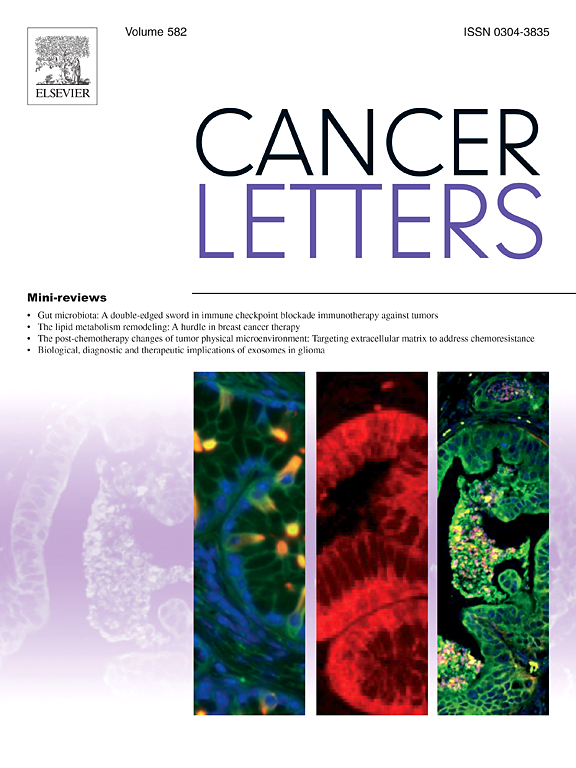纵向 Epstein-Barr 病毒 DNA 与多点肿瘤反应相结合,对鼻咽癌的动态风险分层和治疗适应性具有重要意义。
IF 9.1
1区 医学
Q1 ONCOLOGY
引用次数: 0
摘要
动态治疗反应与癌症预后密切相关。本研究旨在评估纵向爱泼斯坦-巴氏病毒(EBV)DNA和放射学肿瘤消退在局部晚期鼻咽癌(LA-NPC)风险分层和反应适应性治疗中的意义。共有来自两个中心的1312名患者被分配到训练组和验证组。根据对 EBV DNA 和肿瘤反应的多点检测,建立了四个诱导化疗后、四个放疗中期和四个放疗后亚组。然后根据不同的排列和组合进一步产生了七个表型。这些表型随后被归纳为四个反应集群,它们反映了不同的生物治疗反应。在训练队列和外部验证队列中,这四个反应群与明显的 5 年无进展生存期相关(5 年:训练队列 91.1%、82.8%、30.6% 和 10.0%;外部验证 94.4%、55.6%、40.0% 和 12.7%)相比,TNM 分期和提名图模型具有更优越的预后性能(一致性指数:训练队列-0.825 vs. 0.603 vs. 0.756,外部验证-0.834 vs. 0.606 vs. 0.789)。重要的是,反应集群在选择可从辅助化疗中获益的候选者方面表现出卓越的能力。总之,基于放射学和生物学反应的动态评估进行风险分层可显著提高对洛杉矶鼻咽癌预后的洞察力,并为个体化治疗的调整提供启示。本文章由计算机程序翻译,如有差异,请以英文原文为准。
Significance of longitudinal Epstein–Barr virus DNA combined with multipoint tumor response for dynamic risk stratification and treatment adaptation in nasopharyngeal carcinoma
Dynamic therapy response is strongly associated with cancer outcomes. This study aimed to evaluate the significance of longitudinal Epstein–Barr virus (EBV) DNA and radiological tumor regression in risk stratification and response-adaptive treatment in locally-advanced nasopharyngeal carcinoma (LA-NPC). In total, 1312 patients from two centers were assigned to the training and validation cohorts. Based on the multipoint examination of EBV-DNA and tumor response, four post-induction chemotherapy, four mid-radiotherapy, and four post-radiotherapy subgroups were established. Then seven phenotypes were further generated according to different permutations and combinations. These phenotypes were subsequently congregated into four response clusters, which reflect distinct biological treatment responses. The four response clusters correlated with an evident 5-year progression-free survival in both the training and external validation cohorts (5-year: training cohort 91.1 %, 82.8 %, 30.6 %, and 10.0 %; external validation 94.4 %, 55.6 %, 40.0 %, and 12.7 %) had superior prognostic performance compared to TNM staging and nomogram model (concordance index: training cohort—0.825 vs. 0.603 vs. 0.756 and external validation—0.834 vs. 0.606 vs. 0.789). Importantly, the response clusters exhibited an excellent capability in selecting candidates who can benefit from adjuvant chemotherapy. In conclusion, risk stratification based on the dynamic assessment of both radiological and biological responses can significantly enhance prognostic insights and shed light on individualized treatment modifications in LA-NPCs.
求助全文
通过发布文献求助,成功后即可免费获取论文全文。
去求助
来源期刊

Cancer letters
医学-肿瘤学
CiteScore
17.70
自引率
2.10%
发文量
427
审稿时长
15 days
期刊介绍:
Cancer Letters is a reputable international journal that serves as a platform for significant and original contributions in cancer research. The journal welcomes both full-length articles and Mini Reviews in the wide-ranging field of basic and translational oncology. Furthermore, it frequently presents Special Issues that shed light on current and topical areas in cancer research.
Cancer Letters is highly interested in various fundamental aspects that can cater to a diverse readership. These areas include the molecular genetics and cell biology of cancer, radiation biology, molecular pathology, hormones and cancer, viral oncology, metastasis, and chemoprevention. The journal actively focuses on experimental therapeutics, particularly the advancement of targeted therapies for personalized cancer medicine, such as metronomic chemotherapy.
By publishing groundbreaking research and promoting advancements in cancer treatments, Cancer Letters aims to actively contribute to the fight against cancer and the improvement of patient outcomes.
 求助内容:
求助内容: 应助结果提醒方式:
应助结果提醒方式:


